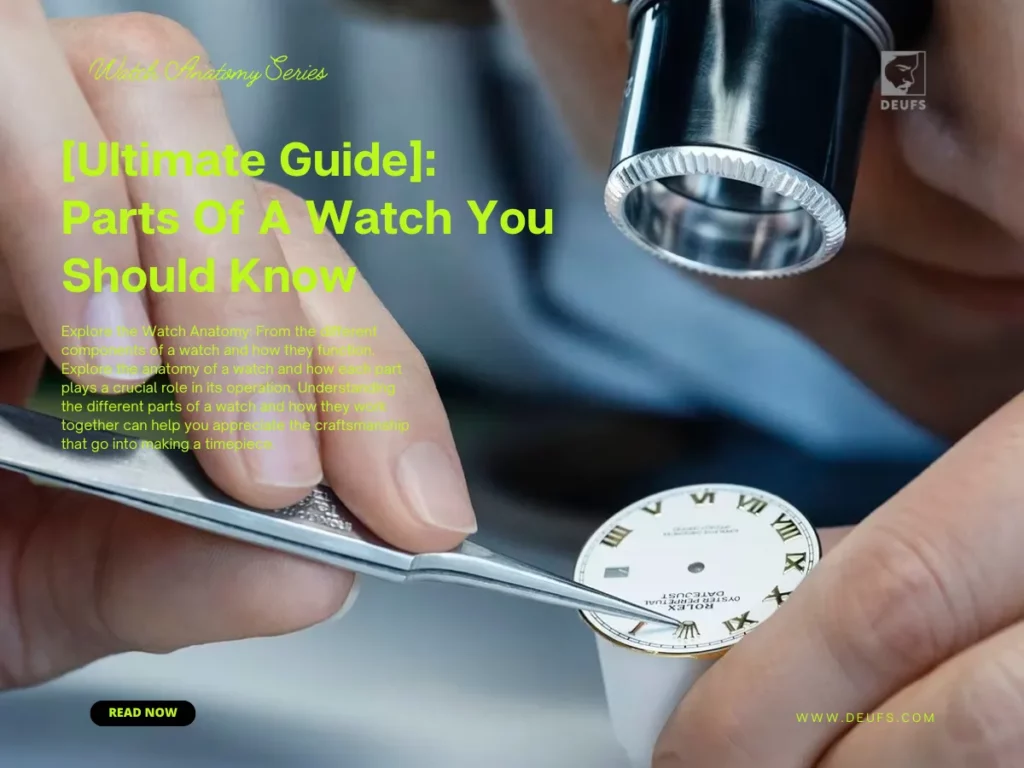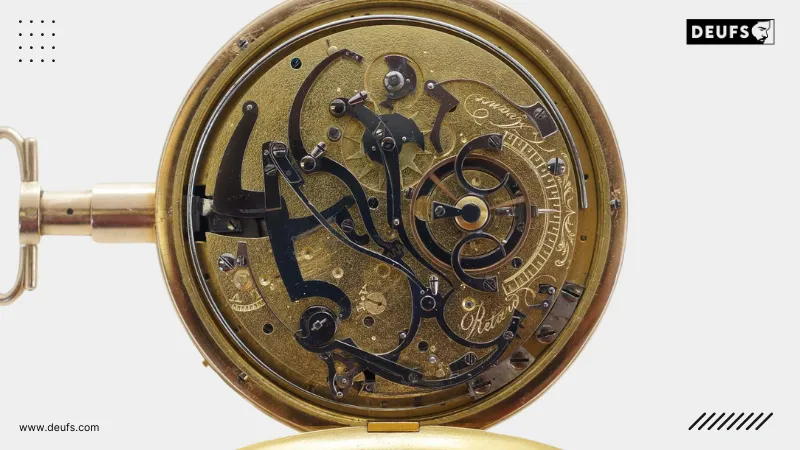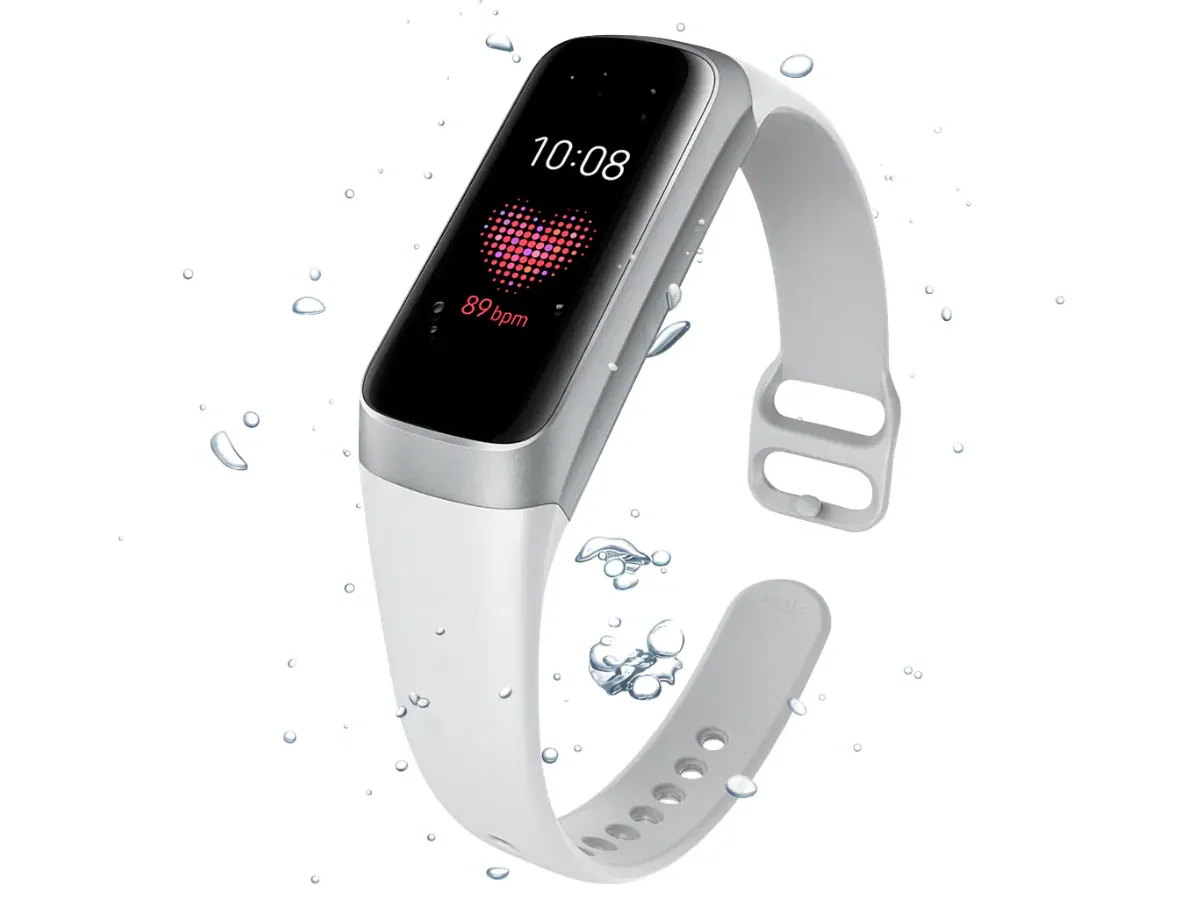Introduction

A watch is a complex piece of machinery with hundreds of tiny parts working together to keep time accurately and reliably. Understanding the different parts of a watch and how they work together can help you appreciate the craftsmanship and technical prowess that go into making a timepiece.
In this article, we will take a closer look at the different components of a watch and how they function. From the case and the movement to the hands and the strap, we will explore the anatomy of a watch and how each part plays a crucial role in its operation.
Face or Display
The watch face, also known as the watch dial, is the area of the watch that you see when you look at it. It is the part of the watch that has numbers and other indicators on it, such as a date window or a second hand. The watch face is typically made of glass or crystal, and it is the most visible part of the watch. The watch dial, on the other hand, refers to the entire mechanism inside the watch case that allows the watch to tell time.
There are many different types of watch faces, each with its own unique style and design. Some of the most common types of watch faces include:
- Analog watch faces: These watch faces have traditional hour and minute hands, as well as a second hand, to indicate the time. They often have a clean, classic look that is timeless and elegant.
- Digital watch faces: The time is shown on these watch faces using numbers or other symbols to show the time. They often have a modern, sporty look and can include extra features like a stopwatch and alarm functions.
- Dual time watch faces: These watch faces have two sets of hour and minute hands, allowing the wearer to track the time in two different time zones. They are perfect for travelers or people who need to keep track of time in multiple locations.
- Complex watch faces: These watch faces have extra features and complications, like a chronograph, an indicator for the moon phase, or a power reserve indicator. They are perfect for watch fans or collectors who like that these watches are more complicated and well-made.
Okay, now let’s get down to brass tacks.
Analog

Analog watch faces are the most classic and traditional type of watch face. These watch faces have a circular dial with hour markers around it, as well as hour and minute hands that move in a counterclockwise direction. The position of the hands on an analog watch face indicates the time of day, so you don’t have to set them every time you put on the watch.
Analog watch faces are known for their timeless appeal and classic design. They are the most well-known type of watch face, and are often associated with elegance and luxury. They are easy to read and understand and are perfect for those who appreciate the simplicity and elegance of a traditional watch.
Whether you prefer a simple and elegant analog watch face or a more complex and sophisticated one, there are many different options to choose from. From classic dress watches to sporty chronographs, there is an analog watch face that is perfect for every style and occasion.
Digital
Digital watch faces offer a modern and versatile alternative to traditional analog watch faces. These watch faces use a liquid crystal display (LCD) to show the time in a digital format. This means that digital watch faces can display a variety of information such as time, date and functions like alarms and timers.
Digital watch faces are known for their versatility and convenience. They are often easier to read than analog watch faces, particularly in low-light conditions, thanks to features like backlights. Additionally, digital watch faces can be programmed to display the time in different formats, such as 12-hour or 24-hour time, making them a great choice for people who travel frequently or need to track time in multiple time zones.
Digital watch faces are also popular among people who are into fitness and outdoor activities. Many digital watches feature features such as heart rate monitors, pedometers, and GPS, making them ideal for tracking your health and performance. Whether you are a tech-savvy gadget enthusiast or a fitness enthusiast, there is a digital watch face that is perfect for you.
Chronograph
Chronograph watch faces are a type of watch face that combines the functions of a timepiece and a stopwatch. These watch faces are often used by people who need to measure elapsed time, such as athletes, pilots, and race car drivers.
Chronograph watch faces typically have two buttons on the side that allow you to start, stop, and reset the timer. Some chronograph watch faces use an hour hand to measure elapsed time up to 12 hours, while a central seconds hand counts off seconds. This type of chronograph watch face is known as a tachymeter.
Chronograph watch faces are popular among people who are into sports and outdoor activities. Many chronograph watch faces have features like split times and memory modes, which make them ideal for tracking your performance and progress. Whether you are a professional athlete or a weekend warrior, there is a chronograph watch face that is perfect for you.
Skeleton
A skeleton watch is a type of timepiece that has a transparent case, allowing the viewer to see the inner workings of the watch. This type of watch is often prized by collectors and enthusiasts for its intricate design and technical prowess.
The most common type of skeleton watch has an open dial that reveals all the gears and wheels inside the watch. This type of skeleton watch is great for showcasing high-end movements, such as automatic movements, which are more complex and difficult to produce than quartz movements. Some skeleton watches may also have extra features or complications, like a chronograph or a moon phase indicator, that add to the watch’s technical sophistication and aesthetic appeal.
Skeleton watches are typically considered high-end or luxury watches, and they are often associated with prestigious watch brands and high-end fashion. The transparency of a skeleton watch makes it a truly unique timepiece, as it allows the viewer to admire the craftsmanship and attention to detail that went into the watch’s movement.
Smartwatch
A touch screen, GPS, and fitness tracking are just a few of the technological features that can be found in a smartwatch. These watches can offer a wide range of extra features and functions, including notifications, fitness information, and apps, because they are connected to smartphones.
The face of a smartwatch can be customized to show different information and functions, such as notifications, fitness data, and apps. Some smartwatches also have the ability to switch between different watch faces, allowing the wearer to choose a watch face that suits their personal style and preferences.
Smartwatches have the added advantage of being able to connect to the internet and other devices, which enables them to provide a wide range of additional features and functions in addition to timekeeping. Making and receiving phone calls, sending and receiving text messages, and having access to apps, music, and other services are some examples of these features.
Hybrid face
A hybrid watch is a type of watch that combines the features of a traditional watch with those of a smartwatch. In addition to having a built-in fitness tracker and other smart features, these watches typically have a conventional watch face with hands. With the help of a smartphone connection, hybrid watches can access extra features and capabilities like notifications and fitness information.
The face of a hybrid watch is a combination of a traditional watch face and a smartwatch display. The watch face may show the time and date using traditional hands and markers, but it may also have a small digital display that shows additional information, such as notifications and fitness data.
Overall, a hybrid watch is a type of watch that combines the classic look of a traditional watch with the added features and functions of a smartwatch. These watches are a good option for people who want a watch that can provide both timekeeping and smart features, without sacrificing the traditional look of a watch.
Case
The case of a watch is the body of the watch itself, and it can be made from a number of different materials. The most common material for cases is stainless steel, because it’s durable and looks nice. Other metals, such as titanium or gold, are also used, but these are generally more expensive than stainless steel.
Case Material
Although some manufacturers are always experimenting with case materials. This is the most common material used in watch cases:
Platinum
Platinum is a highly sought-after material for watch cases due to its rarity and purity. It is one of the most expensive metals used in watchmaking, and it is often considered a symbol of luxury and prestige. Platinum is purer than gold and has a silvery-white color that is highly prized for its aesthetic appeal.
One of the main advantages of platinum is its durability and resistance to corrosion. Platinum is a strong metal that doesn’t easily scratch or dent, making it a great choice for watches that are worn frequently or in harsh environments. Its resistance to corrosion also makes it a great choice for watches that are worn near water or in areas with high humidity.
However, platinum is also a relatively soft metal, which means it can be scratched or dented if it is not handled with care. Additionally, due to its high cost, it is not suitable for every type of watch. As a result, platinum is mainly used in high-end luxury watches or limited-edition watches.
Gold
Gold is a popular material for watch cases due to its aesthetic appeal and affordability. It’s a soft metal that is easy to mold and shape into any form, making it a versatile option for watch designers.
Gold also has a rich color that adds a touch of luxury to any watch. However, the softness of the metal can make it prone to scratches and dents. To overcome this issue, many manufacturers use gold plating or coating on their watches. This adds a layer of protection to the watch and makes it more resistant to scratches and dents than pure gold.
Additionally, Swiss watchmakers are known for their craftsmanship and attention to detail, which is why they tend to use gold plating or coating instead of solid gold to ensure that their watches are durable and long-lasting.
Stainless Steel
Stainless steel is probably the most used material for watch cases.
Stainless steel is a highly durable metal that doesn’t scratch or dent easily. It’s also hypoallergenic, so it won’t irritate your skin like some other metals.
Stainless steel watch cases are often made from 316L grade stainless steel, which has a slightly higher amount of nickel than regular stainless steel used in consumer products. This gives it a darker appearance but still allows the watch to hold up well over time thanks to its durability.
Titanium
Titanium is a lightweight metal that has a high strength-to-weight ratio. This makes titanium cases ideal for watches, which need to be light enough that they don’t weigh you down but strong enough that they won’t break easily.
Titanium cases are also more resistant to scratches and dents than pure gold. A platinum watch case is usually made from 100% platinum (more precisely, it’s an alloy of 90% platinum and 10% iridium).
Ceramic
Ceramic is an extremely hard material that’s often used in watch cases because of its scratch-resistant properties. It’s also very light and durable, making it an ideal material for watches.
But they can be fragile and tend to break if dropped or hit by something sharp. A ceramic watch case is usually made from zirconium oxide, which is a high-strength refractory ceramic that’s often used in industrial applications like nuclear reactors and rocket engines because it can withstand extreme heat without melting or corroding.
Case Shapes Commonly Used
For the designers, the shape of a case is a representation of art and concept. For others, it’s all about practicality and function. Whatever the case may be, there is no denying that the shape of a watch case can have an impact on its overall look.
There are a number of different shapes available for you to choose from when shopping for your next timepiece. Here are the most common shapes on the market:
Round Shape Case
The round shape is the most common watch case shape. It’s often referred to as a “classic” or “traditional” design, and it’s available in both men’s and women’s watches. The round case can also come in different shapes like tonneau (a rounded barrel shape), cushion (which has rounded edges on the top and bottom with straight sides), and teardrop (which is similar to a curved drop of water).
Rectangle Shape Case
The rectangle shape is another popular watch case design. It’s available for both men and women, and it comes in both casual and dressy styles. Rectangular cases can be thin or thick, depending on the brand and style, but they typically have straight sides that are squared off at the top, bottom, or both.
Tank Shape Case
The tank shape is a popular option for men’s watches, and it’s available in both casual and dressy styles. Tank watches have rounded cases that are thicker at the top of the face and thin out as they approach the bottom. Some tanks also have curved edges on their sides, which adds visual interest to this style.
Square Shape Case
Square-shaped cases are a classic choice for both men and women. They’re commonly available in both casual styles and dressier versions, and they have straight sides that are squared off at the top, bottom, or both.
Oval Shape Case
The oval case is a great choice for both men and women, especially if you have small wrists. The curved shape makes it easier to wear an oversized watch without making it look awkward on your wrist. It’s also available in both casual and dressy styles, so you can find one that matches your personal style.
Carre Shape Case
The Carre is a classic case. It has a straight, rectangular case with rounded corners and curved lugs that angle away from the face of the watch. This is another style that can be worn by both men and women, but it’s most commonly found on men’s watches.
Carage Shaped Case
The Carage shape is basically an oval placed in a horizontal position . It’s a more feminine style that works well for women who want to wear oversized watches. The Carage shape is not common for men’s watches, but it can be found on some models.
Tonneau Shape Case
The tonneau shape is a rounded rectangular case that is wider at the top than it is at the bottom. The name “Tonneau” comes from a French word that means “barrel” and that’s exactly what this style looks like . It has rounded corners and curved lugs that angle away from the face of the watch (just like a barrel).
Case with an Asymmetrical Shape
As the name suggests , an asymmetrical watch case is not symmetrical (or balanced). The shape of the case may be off-center or have a combination of different angles. This style is popular with men’s watches because it looks masculine and modern.
The asymmetrical case typically has a top that is straight and an angled bottom. Compared to other designs like the Tonneau or Rectangular case, this gives it a more natural appearance.
Bezel
A bezel is a ring that sits on the edge of the watch case and surrounds the dial. It can be used to display information such as time, date, or other functions like diving modes. The most common type is a fixed bezel, which means it doesn’t move, so you have to adjust your wrist when using it. A rotating bezel (also known as an “elapsed time bezel) can rotate around the watch case, allowing you to track how much time has passed since an event occurred (like a dive).
Diving Bezel
A diving bezel is a type of watch bezel that rotates. It is used to count the time that has passed while underwater and is usually found on dive watches. When you look at a diving bezel, it will have different markings around its edge that indicate how much time has passed since an event occurred (like a dive).
Timing Bezel
A timing bezel is a type of watch bezel that is used to measure time. It is usually found on pilot watches, but can also be found on chronographs and dive watches. A timing bezel has markings around its edge that indicate which minute you are in (1-60), as well as a small triangle at 12 o’clock indicating AM or PM.
Caseback
The caseback is the back of your watch and usually has a unique design that’s not visible from the front. It could also be written on or have other information about the watch, like the model number or the date it was made.
For some watches, you can see through their casebacks to view their movements (the heart of any mechanical watch). These transparent cases are called exhibition cases.
Crown
The crown is used to adjust the time, and it’s often used to set the date. Not all crowns are designed the same way, though. Some can be pushed in to set the time (like a button), while others can be pulled out to set it (like a lever). Some have both push-in and pull-out functions. The crown is also used for winding a mechanical watch when you don’t wear it for an extended period of time.
Dial
The dial is the front face of your watch. It will be made of metal and contain all the details you need to tell time. You can also see some sort of decoration on it, like markers or indices, which help you read the time more easily. The dial can also be made entirely out of plastic, or a combination of metal and plastic.
The base of the dial itself can be formed in various styles, here are some common dial styles made by manufacturers:
Plan dial
The most common type of dial is the plan dial, which has a round shape with flat sides and no curved edges. Most of the time, the surface is made of metal and has markings that show the hours and minutes. The center of the dial usually contains numbers for hour markers, while smaller lines called “indexes” are used to mark each minute.
Textured or patterned dial
Textured dials are made with a surface that has a pattern or texture. This can be done by pressing in marks into the metal, etching it with acid, painting on a design, and more.
The level of detail will vary depending on how much effort is put into making it. Here are some examples of the most widely acknowledged dial patterns:
Linen texture dial
A very common design in the watch industry is the dial with a linen texture. Products from numerous companies exhibit it. The dial’s use of a linen texture is intended to give the watch a more elegant appearance.
A texture known as “linen texture” has erratic patterns and lines that resemble linen cloth. The linen texture dial can be used with any type of watch and has a simple, elegant design. This type of dial is used in many well-known brands’ products, including watches from Rolex and Omega.
Tapisserie texture dial
In essence, a tapestry-like pattern of repetitive motifs makes up a tapisserie texture dial. Due to this pattern’s resemblance to a waffle, some people have also referred to it as a “waffle-pattern.”
This watch’s dial was created by using a burin, a tool used to engrave metal, to etch lines into a sheet of brass. Using a pantograph, a device that reproduces a drawing at various sizes, the pattern on the dial was made.
Audemars Piguet is a well-known company that employs tapisserie dials.
Guilloche texture dial
A watch dial’s surface can be engraved with a design called a guilloche texture dial, which consists of delicate curves and lines. The French word guilloche, which means “to engrave,” is where the word Guilloche originates.
Early 18th-century French pocket watch cases featured the guilloché texture dial for the first time. It was not common among watch manufacturers as a decorative component for their timepieces until the 19th century.
Guilloche patterns can be made in a wide variety of ways today, but they are typically produced by one of three methods: hand engraving, engine turning, or laser etching.
The most popular guilloche pattern consists of regular intersections of straight lines to produce a woven appearance. Known as rosace (rose) guilloché, this pattern is frequently used to adorn fine jewelry and pocket watches.
Marquetry texture dial
The watch face is designed with a marquetry dial made of a variety of materials. It is a particular type of dial that adds to the decorative appeal and value of the watch. The pattern, color, texture, and other characteristics of the marquetry dial are just a few of its many varieties.
Marquetry can be made from a variety of materials, including metal, wood, bone, and precious metals.
Teaked texture dial
The surface of a watch with simple vertical or horizontal lines engraved on it is called a teaked texture dial. Teaked texture was given this name because of its shape, which resembles a carefully arranged stack of wood.
The Dutch language is where the word “teaked” originates. Its name is derived from the word “teak,” which describes a distinctively reddish-brown tropical hardwood. Since the 17th century, the word has been used as an adjective to describe things that resemble this wood, such as leather shoes and wooden objects (like tables).
Skeletonized dial
A dial that has been skeletonized makes it possible to see how the watch is moving. Recent years have seen a rise in the popularity of this design element on wristwatches, especially among high-end manufacturers like Rolex and Omega.
The earliest use of skeletonized watches happened in the 1760s, when Frenchman André-Charles Caron invented the first skeleton watch by removing the outer case from a pocket watch to reveal the inner workings.
Skeletonized watches are popular among people who like mechanical watches and appreciate the beauty of their inner workings. Some say that skeletonized dials are easier to read because they show more clearly where each hand should be pointing.
Indices
The watch dial has a unique indices design to show the hours and minutes in addition to its overall appearance.
The indices are basically the hour markers on a watch face. These are the numerals that make up the hours, minutes, and seconds on a watch face. We often simply call them “the numbers” or “the markers.”
The examples below show some of the most popular types:
Arabic Indices
Arabic numerals are the most common type of numeral system used in the world today. It is the standard number system in both English and French, and is often used in other languages. It also happens to be the most commonly used numeral system in watches.
They come in many different styles, but most commonly, you will see them as simple black or white numbers against a backdrop of color. The background can be any color you want, but it is usually blue or black.
Stick Indices
These watches use small bars to represent the hour rather than full numbers like Arabic dials do. The bars are very thin lines that are placed horizontally across the watch face to form what looks like sticks lying on their sides.
This type of marking is popular among more expensive watches because it gives them an elegant look that works well with both casual and formal clothing styles.
Arabic & Stick Indices
Arabic & stick marking are basically a combination of both of the above types. Stick dials are usually used to mark the hours, while Arabic dials are used for smaller information such as minutes and seconds.
Roman Indices
A Roman dial is a timepiece that only uses Roman numerals to tell the time. A Roman dial is a simple and elegant way to tell time without using any numbers or other symbols on the face of the watch.
California Indices
A California dial is marked with half Roman and half Arabic numerals. The minute track is also divided into two halves, and the outer ring has a small chapter ring and an outer track for seconds.
During World War II, the high-visibility dial was created to make it easier for soldiers to tell time in low-light conditions.
Diver Indices
Diver indices are the hour markers used on dive watches. The most common diver indices are batons, which are hour markers shaped like arrows. These batons point toward 12 o’clock and generally have white luminescence to reflect light in the dark. The hour markers are often outlined with lume paint as well.
Hour markers that resemble numbers, called numerals. They often have a combination of lume paint and white luminescence, but they can also be made in a variety of colors or patterns.minutes
Hour markers that look like triangles with an arrow-shaped tip at the top (like a shark’s fin), called triangles. Like numerals and batons, these can be made with different colors or patterns and can have white luminescence or lume paint outlining them as well.
Kontiki Indices
Kontiki Indices are a unique way to display the time. Instead of numbers and hands, Kontiki indices display the time using small discs.
Kontiki indices are often used by brands that specialize in dive watches, but they can also be found in other styles of watches.
The most common type of Kontiki index is the triangle index. This index has three arms that point to the hours, and seconds on a dial. The top arm indicates the hours, the middle arm indicates minutes and the bottom arm indicates seconds. There’s also a fourth arm that corresponds to the date.
Flieger Indices
The Flieger index is a unique feature of pilot’s watches. It’s a dial that has been designed to be used in conjunction with a slide rule, which is an instrument used by pilots and navigators to perform mathematical calculations.
The flieger index is a set of numbers printed on the bezel or the dial of an aviation watch. The numbers are spaced out evenly around the rim of the watch, so that they can be referenced easily while doing calculations. There are several different types of flieger indices, including:
Hands
The hands are the parts on your watch that point to the numbers. You can see them moving as you look at your watch, and they tell you how long it’s been since a certain hour.
There are three types of hands: hour, minute, and second.
Hour Hand
The hour hand is the long hand in a clock or watch, and it is used to tell the time. It moves around the face of the clock once every 12 hours and takes 60 minutes to do so. The number on it indicates which hour is being shown at any time, with zero being midnight.
Minute Hand
The minute hand is the short hand in a clock or watch, and it is used to tell the time. It moves around the face of the clock once every 60 seconds and takes 30 minutes to do so. The number on it indicates which minute is being shown at any time, with zero being noon (midday).
Second Hand
The second hand is also known as a sweep second hand because it sweeps around as opposed to ticking like a normal second hand would do. It moves around once every second and takes 60 seconds to complete its journey once around the face of a clock or watch face
In addition to showing the time accurately, watch hands also have various designs, styles, and variations. However, here are the 14 most commonly used watch hand styles:
- Alpha hand style
- Syringe hand style
- Baton hand style
- Dauphine hand style
- Cathedral hand style
- Mercedes hand design
- Breguet hand style
- Snowflake hand style
- Arrow hand style
- Lance hand style
- Lead hand style
- Plongeur hand style
- Spade hand style
- Sword hand style
Crystal Glass
The crystal is the window to your watch’s movement, and it can be made of glass, sapphire, or ceramic.
Mineral Glass
It’s basically glass that has been hardened by a chemical process. It won’t scratch as easily as ordinary glass, and it’s more scratch resistant than acrylic crystal. It’s the most common material used in watches. It’s less expensive than sapphire but more likely to break if hit by a hard object.
Synthetic Sapphire Crystal
Synthetic sapphire is a transparent form of aluminum oxide that’s harder than both diamonds and topaz. It’s the second hardest natural substance on Earth, just behind corundum (which is found in ruby and sapphire).
The synthetic process used to make synthetic sapphire crystal is similar to that used to make artificial diamonds. It’s harder than mineral glass and less likely to get scratched because of that, but it’s also more expensive and heavier.
Acrylic Crystal
Acrylic is used as a watch crystal because it’s cheap, shatter-proof, and scratch-resistant. It’s also lightweight and can be made in a variety of colors. It doesn’t last as long as mineral glass or sapphire crystal, and over time it tends to turn yellow.
Movement/Caliber
Simply put, the movement is the mechanical part of a watch that makes it work, while “caliber” is the term for the movement type and size.
The movement of a watch is the mechanism that actually tells time. It’s the engine of your watch that keeps it running and allows you to see what time it is. It contains the parts that produce energy to power its functions.
There were only three watch movements: manual (requiring winding), automatic (self-winding), or quartz. For your information, both manual and automatic are mechanical and not electronic. They use a series of gears, springs, and other parts to keep time.
Manuals are powered by a mainspring, which must be wound up by turning a crown. Automatic watches have a rotor that winds itself to power their functions. Quartz watches run on battery power and do not require winding or recharging.
Straps/Bracelet
The strap or bracelet, also known as the band of a watch, is an essential part of a watch. It is the part that goes around your wrist. The straps and bracelet are made from many different materials.
The most common materials for the straps and bracelet are leather and metal. They can also be made out of rubber or plastic.
Leather is a material that is commonly used for straps and bracelets. Leather is very durable and can last a long time. It also looks good on most watches and comes in various colors and styles.
Rubber straps are widely used in sports and diving watches due to their high flexibility, durability, and ability to resist water pressure at great depths. It is also highly resistant to shocks and scratches.
Conclusion
As you can see, timepieces are almost as complex as finely designed machines. The level of precision required to properly design a watch is outstanding, and attention to detail is essential in ensuring that the components function together to make an accurate movement. In general, watches are works of art and carry the status of such.
I hope this post helped you understand watches better. If not, then my mission is a failure!






